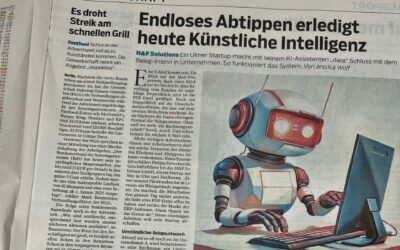From data chaos to data clarity: PDF formats in document processing

FOCUS ON UNSTRUCTURED DOCUMENTS
Barriers and challenges in document exchange
In today’s dynamic and digitalized business world, in which the efficient exchange of data between companies is crucial to their success, document processing remains one of the biggest challenges for companies. Every year, around 1.2 trillion documents, including orders, order confirmations and invoices, are exchanged between companies. In the digitalized world of the 21st century, you would think that this document exchange would run smoothly and fully automatically, but the reality is different:Just 5% of receipts are transmitted automatically between companies.
Unstructured documents in particular, such as the PDF (Portable Document Format), are proving to be an almost insurmountable hurdle for companies. This is because with unstructured documents, the various document items shift depending on the company and layout used. These often contain multi-layered and complex information and, due to their complexity, are often delegated to employees to transfer the data manually but contextualized – and this in the age of advancing digitalization. This process is not only time-consuming and error-prone, but also a real obstacle to productivity.
The complexity of document exchange is further exacerbated by different systems and data formats. Large ERP system providers have so far shown little initiative in facilitating the flow of data between different systems. This disconnects companies from the outside world through an invisible data barrier. While internal processes have been optimized and made scalable, strategic partnerships and new commercial relationships often degenerate into mere declarations of intent. But how can this barrier be overcome to achieve a state of flexibility, efficiency and freedom within document exchange?
The illusory solution is called Optical Character Recognition (OCR)
In the business world, many companies already rely on technologies such as OCR (Optical Character Recognition), to improve the exchange of documents. This solution canimprove efficiency and productivity to a certain extent in the area of document exchangeit but itinevitably reaches its individual limits. Systems based on optical character recognition (OCR) are capable of identifying text content and extracting data from it, but failn then the correct interpretation and assignment of this information. information. This leads to an unavoidable change in the structure of unavoidable manual post-processing, since each PDF layout of each customer requires individual adjustments. The datavalidation and correct data processing must still be carried out by an employee – i.e. a higher intelligence. OCR is therefore an important step, but only one of many in the complex sequence required to generate a fully integrated document in the target ERP system from an unstructured document such as a PDF file.
Even high developed Large–Language–Models (LLM)such as ChatGPT, reach their limits when it comes to combining process-related and cross-context information from various processing steps in a holistic algorithm. Managing the data chaos requires more than just the ability, to recognize and extract data. An intelligent solution is needed that not only specifies which data should be extracted, but also provides contextual information to correctly understand the data and assign it to the right field in the system.
Intelligent Data Interchange (IDI) brings order to the data chaos
The good news is that there is a more efficient solution than several stepe back in the digital revolution and transferring receipts manually. The AI-based technology dara® enables thereby the processing of data from structured and unstructured documents by means of intelligent data exchange, also known as Intelligent Data Interchange (IDI) called. This opens up a holistic approach in the receiptprocessing, which covers various process steps, from data extraction to data integration. This approach promises more efficient and intelligent processing of documents, with minimal need for human intervention and creates thus absolute clarity in the data chaos of document processing.

The automated exchange of data between ERP systems is made possible by dara® using Intelligent Data Interchange. Both unstructured data and structured data can be processed. Unstructured formats include, for example, PDF, scan or fax.
Relevant information is first extracted from unstructured documents using AI-based data classification. This not only identifies the required information, but also creates a structure for further processing. After the necessary contextualization, the data is then optimized using patented data enrichment. For example, missing article numbers or address data are added, homogenized and corrected. External data sources are included for this purpose. Using these patented processes, dara® is able to close data gaps, increase process efficiency and reduce process costs.
The resulting higher data quality means that less manual intervention is required and feedback from employees is only requested proactively and interactively by the system in specific cases. In turn, the system learns from the feedback provided and can further increase the degree of automation. This means that, based on the feedback, dara® will be able to make the requested decision itself in future and take on the role of an intelligent, virtual assistant. The data is then transformed into the target format based on the specified target ontology and made available for the target ERP system.
The holistic approach of dara® covers all process steps, minimizes the need for human intervention and enables easy adaptation to individual requirements in terms of data correction, source and target formats and layout. As a result, a degree of automation of up to 99 % is possible using Intelligent Data Interchange, even for unstructured documents.
Intelligent data exchange as motorr for the corporate success
The high degree of automation through Intelligent Data Interchange (IDI) enables companies not only to increase efficiency enormously, but also to reduce manual intervention, which saves a considerable amount of time and resources. The technology simplifies the onboarding of new business partners and improves the management of existing business relationships by integrating a certain degree of individuality of the user parties and no longer relying exclusively on the synchronization of master data. This takes the way in which receipts are processed to the next level.
This heralds an era of data clarity and automated data exchange in the area of document processing of structured and unstructured formats. With annual market growth of 2 % In document exchange between companies, dara® uses Intelligent Data Interchange to transform data chaos into a future of clarity, efficiency and scalability.
#document exchange #data exchange #data flow #document exchange #EDI #nextlevelEDI #IDI #OCR #RPA


